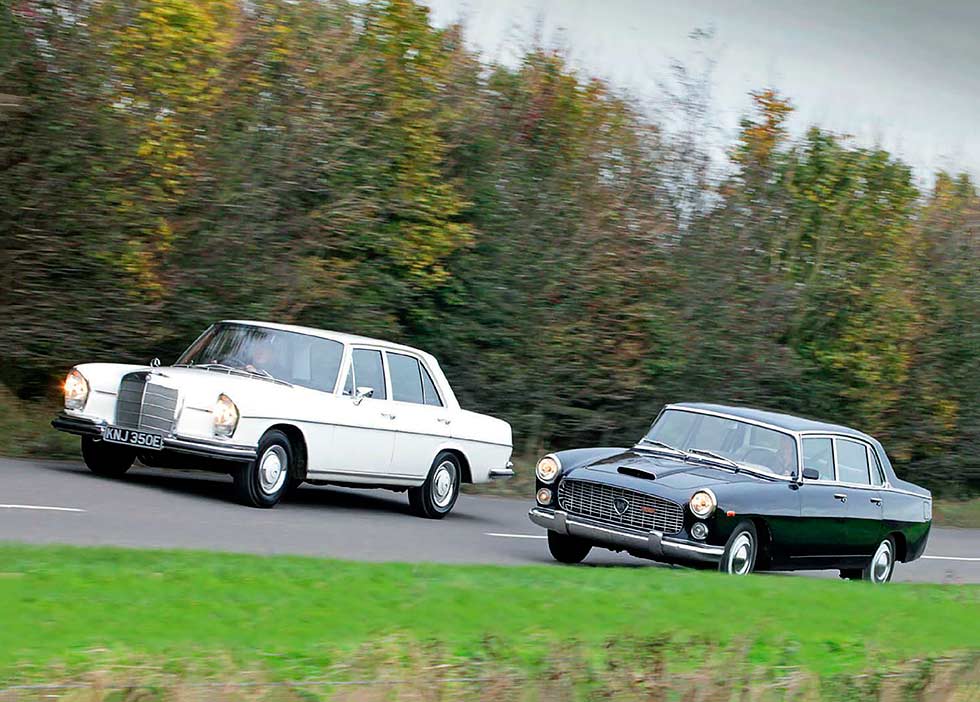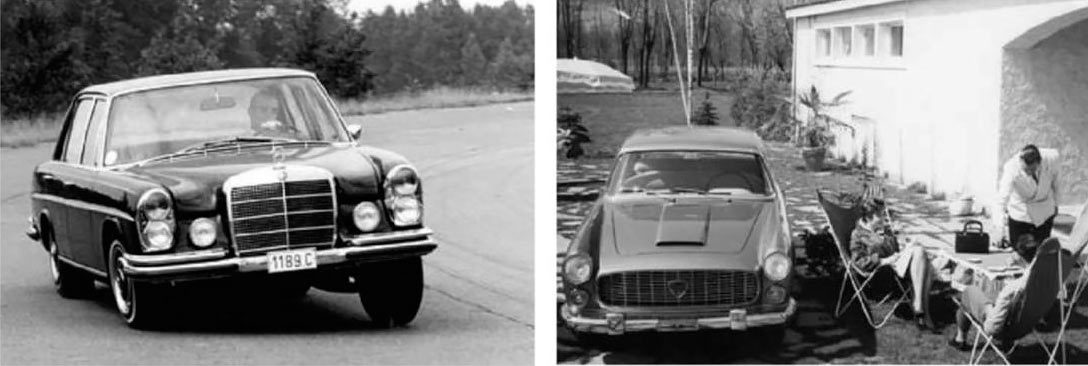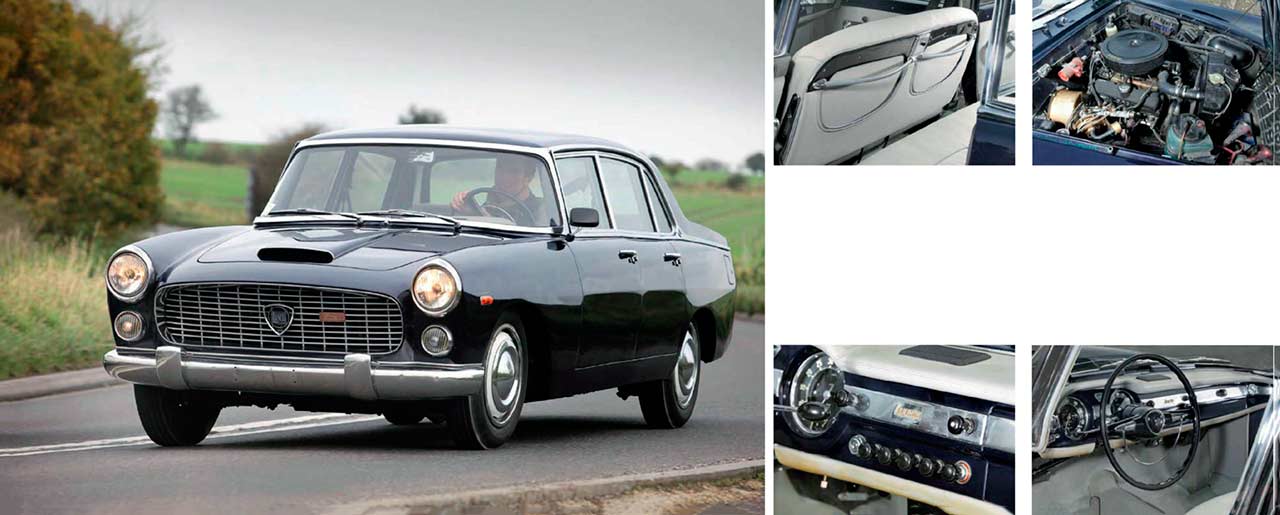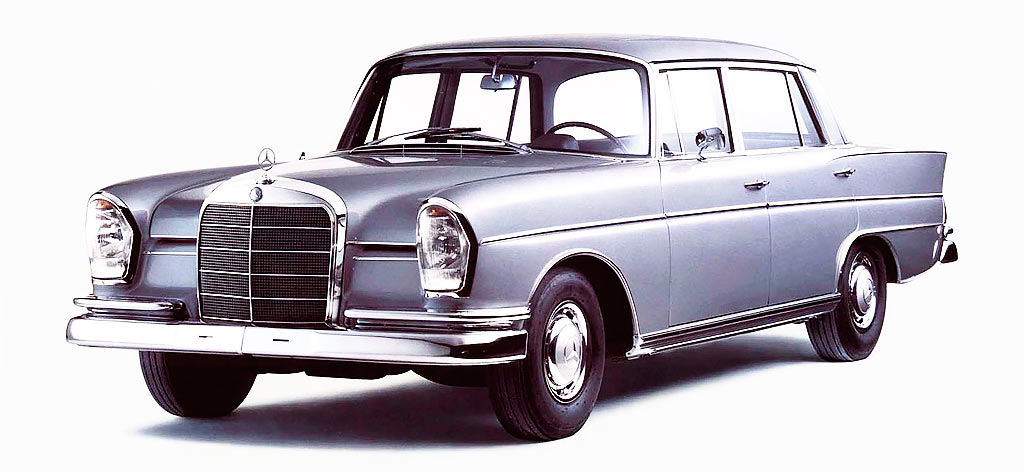
Lancia vs. Mercedes Flaminia takes on the mighty 300SE. Flagship 1960s six-cylinder models from Lancia and Mercedes-Benz. Engineered for excellence. The Lancia Flaminia and Mercedes-Benz 300SE were both high-water marks in the world of prestige European saloons, says Martin Buckley as he attempts to choose between them. Photography James Mann/LAT.
During the 1950s and ’60s, most patriotic Italians would have told you that the four-door Lancia Flaminia was their biggest and best car, working on the basis that a Ferrari or a Maserati was really a thinly disguised racing machine – a vehicle so absurdly expensive and rarefied that people couldn’t relate to it. A Flaminia Sedan, in contrast, was an approachable glamour car, not only the favoured transport of church and state, but also industrialists and even the occasional Grand Prix star, such as Juan Manuel Fangio and Peter Collins.
Introduced in 1957 as a 102bhp 2½-litre, this was Lancia’s luxury statement for the following decade, taking up where the Aurelia B12 had left off with a more refined (and heavier) version of the V6 concept. It still ran a four-speed transaxle and leaf-sprung de Dion tube, but with unequallength wishbones at the front replacing the earlier cars’ shimmy-prone sliding pillars.

The early Flaminia Sedans had Aurelia B20-type drum brakes (discs all round were standardised after the first 500 had been built) plus a bizarre inner and outer wiper set on the rear window, working off the same vacuum system that opened and closed the rear quarter windows. The invention of the heated element for the rear glass banished the quad wipers at about the same time that Lancia boosted the power of the all-alloy, wet-liner V6 to 110bhp in 1961. It quickly followed this in ’1962 with a 129bhp 2.8-litre version. Amazingly, the last Flaminia saloons were sold in 1970, although when they were actually built is anyone’s guess. The flagship Lancia was, in effect, usurped in the hierarchy of Italian saloons by the Fiat 130 V6. Although it still commanded respect, the Flaminia had always suffered from a desperate lack of development, never getting the power steering, automatic transmission and effortlessly powerful engine that the market demanded.
Sales figures neatly tell the story. The Sedan sold briskly in its first year of production (2600 cars) but nose-dived at the beginning of the ’60s, probably as a result of the introduction of the faster, more compact and prettier Pininfarina Coupé, which outsold it handsomely. Total saloon production was just over 4000 examples, including 75 with the oddball Saxomat semiautomatic gearbox and a handful of 140bhp Speciale police cars with twin Webers.
For the purposes of this comparison, perhaps only Mercedes-Benz could furnish a continental six-cylinder saloon of equivalent finish, dignity and technical excellence. In Germany, the 300 badge – which went back to the early 1950s (see opposite) – certainly had a similar resonance and commanded similar respect among buyers.

Introduced in ’1965, Paul Bracq’s masterful W108 is reminiscent of his W111 coupé, with deep windows, slim, sloping roof pillars and a flatter roof. Half an inch lower and wider than the ‘Fintail’, with a larger glass area (and curved side windows to increase space inside), for me it is the best-looking Mercedes saloon of them all.
It doesn’t have the head-turning power of the Lancia, though. While the 300SE has a familiar outline, few people have encountered a Flaminia Sedan. Derived from Pininfarina’s Florida prototypes of the mid-’50s, this brilliant design – with its headlights out in the corners of its straight-through wing line and wide horizontal grille – was a styling sensation: simple, clean and architectural rather than sculptural. It was, in many ways, the first modern three-box saloon, to which most four-door cars of the 1960s owed a debt.
This left-hand-drive 1966 example (one of fewer than 600 2.8s built) belongs to Maserati Club chairman Nick Heywood Waddington, and shares garage space with an array of Italian exotica that would make anyone drool. He bought the Lancia a couple of years ago and, after a little sorting, is delighted with it.
Who wouldn’t be? Its deep blue paintwork forms a dignified contrast with its tasteful stainless- steel bumpers, bold grille and handsome chrome-on-brass window surrounds. Open the front-hinged aluminium bonnet and its V6 looks compact and purposeful, almost overwhelmed by the massive radiator with its thermostatic shutters. The rubber-trimmed boot, meanwhile, is huge (with a trapdoor to access the inboard brakes), its length taking precedence over rear legroom, which is surprisingly tight.
The doors open wide over a deep, chunky sill and shut with a precise solidity that puts even the Mercedes to shame (they share anti-burst safety locks). That feeling flows through to everything about the car, be it the satisfying twist-click action of the chunky dashboard switches or the silky accuracy of its unassisted steering.
The Lancia feels quite formal, with a big steering wheel and an upright driving position on the wide West of England-cloth split-bench front seat; leather or vinyl were options. There is good vision all round – with slight distortions in the corners of the wraparound windscreen – and a beautiful body-coloured dash with handsome, almost dinner-plate-sized speedometer and rev counter.
The chromed buttons for the vacuum rear windows are to the left of the wheel, and further evidence of the obsessive attention to detail can be found in the warning light for the manual choke, the red lights in the doors and the windscreen- washer button that also automatically sets off the wipers. Was that a first on a European car?
Once warm, the pushrod 60º V6 is sweet, flexible and ‘soft’ in tune, its single Solex carburettor enabling you to drive it smoothly and unobtrusively down to low speeds in third and top with the minimum number of changes. It will pull smoothly and quite strongly from nothing to 70mph in a particularly versatile third gear, while the short and quick movement is totally at odds with most people’s perceptions of what a column change is supposed to be like.
The servo-boosted Dunlop disc brakes are fairly heavy, but reassuring, balanced and resilient – and the Lancia’s firm, flat ride deals quietly and disdainfully with everything. Sounding well bred and discreetly throaty, the V6 gives brisk and evenly paced acceleration up to 90mph thanks to its flat torque curve, although the combination of gearing, weight and aerodynamics limits the top speed to about 110mph.
If not exactly fast, the Flaminia puts a smile on your face with its combination of enthusiasm for the task in hand, pleasing refinement and the fact that such an eminently dignified car – on such skinny tyres – can be hustled so quickly through corners, diving in slightly at the front but clamping its de Dion rear to the road with absolute tenacity. The steering is low geared, a little heavy at slow speeds, but seems to gear up as lock increases, so that you never feel as if you are endlessly twirling the wheel.
In short, the Flaminia is magnificent, but very much an experience of the late ’50s or early ’60s. It is not a casual machine but one that demands you drive it with proper attention – a curious mixture of sedate sports car and lusty limousine. The Mercedes, in contrast, feels entirely a car of the mid-1960s that, in many respects, would not have been out of place in the mid-’70s. Its power steering means you can palm it around town with ease, while the automatic transmission – although unrefined by modern standards with its punchy shifts – means that you don’t have to work hard to extract the ample performance.
It is also beautifully made but in a more rational, ‘productionised’ way that doesn’t suggest the laborious hand-work that must have gone into the Lancia. Apart from the elegant inlet manifold for the Bosch mechanical fuel injection, the M189 engine looks very conventional, but physically more imposing than other six-cylinder Benz units of the time.
From inside, the delightfully low waistline makes the 300SE appear even more open and spacious than the Lancia, and there is more legroom in the rear. It must have just about the finest visibility of any 1960s saloon, a factor that makes you feel good straight away, as do the firm but orthopedically correct front seats. Its dashboard, with a narrow slash of plain semi-matt wood, is slightly joyless compared to the Lancia, but it is also simpler and more logically laid out. You don’t have to guess which switch is for the lights or the wipers. In fact, many functions are combined in a single column stalk.
There is no undignified fiddling with choke levers in the Mercedes. The automatic enrichment of the injection takes care of everything and the car is ready to go at once, hot or cold. Even in 2016 terms, this ’1967 300SE is quite fast. There may not be enough power to smoke the tyres, but it has a lot more urge than the Lancia.
With 195bhp (gross, admittedly), it could not fail to be quicker, although it is interesting to discover that the German is 500lb heavier. It’s not so much the off-the-mark acceleration that is impressive, but the mid-range strength between 60 and 90mph that will surprise quite a few modern cars. It’s delivered with a gloriously visceral howl that is 300SL-like in timbre.
I used to own this very car – it now belongs to Jeremy Banks, who also has a pair of Touringbodied Flaminias – so I know that it will cruise at 100mph and top 120 if you’re feeling brave. Like all Mercedes of its generation, it’s low geared (18.8mph per 1000rpm, compared to the Lancia’s 20mph) and there’s no rev counter. Yet the 3-litre ‘six’ feels tireless and was designed to sit flat-out on an autobahn all day long with no more noise than the Lancia. God help you if you do blow it up, though. Even in the world of Mercedes, these are notoriously expensive units to work on.
The handling is not as involving or rewarding as the Flaminia, but its total competence cannot be denied. It feels squat and supple on the road: the 300SE’s coil-sprung ride is so beautifully soft, you seriously wonder why anyone wanted the SEL’s troublesome air suspension. Plus, the power steering is a boon rather than a hindrance to placing the Mercedes accurately. In a straight line, it has all the stability of the Lancia, and when you are moving quickly you pretty much forget it has PAS. It doesn’t wheeze or snatch or deprive you of feel, but just unobtrusively assists. Once you have the measure of its cool efficiency, the 300SE invites you to drive it quite hard; there is a crisp authority to the engine’s sound and delivery that can bring out the Uhlenhaut in some drivers. Holding the big steering wheel and looking out over the three-pointed star, the 300SE has a sense of purpose and command that is always impressive.
It would prove an easier car to live with than the Flaminia and has many practical advantages over the Italian that clearly illustrate Stuttgart’s much more highly developed understanding of the requirements of the 1960s luxury saloon market. You could buy it with your head and heart and never look back, but personally I could never walk away from the sophisticated charms of the Flaminia. If the Mercedes conjures images of ruthless German businessmen tearing up an autobahn in the name of the economic miracle, then the Lancia evokes Bardot purring up to the kerb outside a café or a club on the Via Veneto.
I know where I’d rather have found myself. Most Lancia fans secretly acknowledge that the saloon variants of their favoured model usually offer the most undiluted driving and ownership experience. On that basis, the Flaminia Sedan is possibly the best ‘real’ Lancia of the lot – if you judge it on technical pedigree and refinement. It represents the apogee of the firm’s reputation as a maker of outstanding fourdoor cars. Lancia may subsequently have built several more obviously exciting machines, but never one so exquisitely engineered – perhaps even over-engineered – as this.

Tech and photo
‘ONLY MERCEDES COULD FURNISH A SALOON OF EQUIVALENT FINISH AND TECHNICAL BRILLIANCE’
‘THE FLAMINIA EVOKES BARDOT PURRING UP TO THE KERB BY A CAFÉ ON THE VIA VENETO’


‘IT RIDES SO WELL, WHY WOULD ANYONE WANT THE TROUBLESOME AIR SUSPENSION?’
TECHNICAL DATA FILE SPECIFICATIONS LANCIA FLAMINIA SEDAN 2.8
Produced/number built 1957-’1970/4023
Construction steel monocoque
Engine all-alloy, overhead-valve 2775cc 60º V6, with single Solex 40 PAAI carburettor
Max power 139bhp @ 5000rpm (DIN)
Max torque 187Ib ft @ 5300rpm (DIN)
Transmission four-speed manual transaxle or Saxomat semi-auto, driving rear wheels
Brakes discs all round, with servo
Steering worm and roller
Suspension: front independent, by double wishbones, coil springs rear de Dion axle, semi-elliptic leaf springs, Panhard rod; anti-roll bar f/r
Length 15ft 9in (4801mm)
Width 5ft 8in (1727mm)
Height 4ft 10in (1473mm)
Wheelbase 9ft 5in (2870mm)
Weight 2750Ib (1247kg)
0-60mph 13 secs
Top speed 106mph
Price new £2946
Price now £15,000
{module Lancia Flaminia}
TECHNICAL DATA FILE SPECIFICATIONS MERCEDES-BENZ 300SE W108
Produced/number built 1965-’1967/2737 (including long-wheelbase SELs W109)
Construction steel monocoque
Engine iron-block, alloy-head, single-overhead-cam 2996cc straight-six, with Bosch mechanical fuel injection
Max power 195bhp @ 5500rpm (DIN)
Max torque 203Ib ft @ 4100rpm (DIN)
Transmission four-speed automatic, driving rear wheels
Brakes discs all round, with servo
Steering power-assisted recirculating ball
Suspension independent all round, at front by double wishbones rear single-joint, low-pivot swing axles; coil springs f/r (SEL has air bags)
Length 16ft 1in (4902mm)
Width 5ft 11in (1803mm)
Height 4ft 9in (1448mm)
Wheelbase 9ft ¼ in (2750mm)
Weight 3440Ib (1560kg)
0-60mph 10 secs
Top speed 118mph
Price new £4085
Price now £15-20,000
{module Mercedes Benz W108/109}
Evolution of the Mercedes-Benz ‘six’
In 1951, the large and patrician W186 300 saloon (as used by Chancellor Adenauer) had put Mercedes back on the post-war map as a maker of luxury saloons. At the heart of its appeal was the M186 straight-six, a versatile 3-litre unit that would be developed through to 1967 as the firm’s top-of-the-range passenger-car engine. Variants of it were used in five basic shells (including the 300SL), and it should not be confused with the smaller M180 ‘six’ that was superficially similar but entirely different in detail with almost no shared components.
The introduction of a top-spec 3-litre 300SE ‘Fintail’ (right) in ’1961 brought about the second and final phase of this engine’s development, having been redesigned for the smaller car with an alloy block featuring press-fit dry liners. On 160bhp, it could take the airsuspended 300SE up to 112mph, but in 1964 Mercedes engineers (irked by the arrival of the new 120mph Opel Diplomat) found another 10bhp by fitting an improved six-piston injection pump.

After the W108 body arrived in ’1965, there were no more 3-litre Fintails. The M-B petrol-engined saloon hierarchy was split into four- and six-cylinder Fintails (with carbs and no more than 2281cc) and this new ‘square tail’ body in 250S, 250SE and 300SE/SEL form. The W108 featured several technical improvements, such as four-wheel disc brakes (with twin-diaphragm servo), bigger 14in wheels and a clever hydropneumatic self-levelling unit between the swing axles to keep the rear level under load. You could order the 300 ‘six’ in this latest model in standard 300SEb form with coil suspension (like ‘our’ W108) or as the stretched SEL with air springs (W109). M-B dropped the M189-engined 300 in ’1967, but, confusingly, went on building a 300SEL-badged W109, although powered by an M180 2778cc unit.





